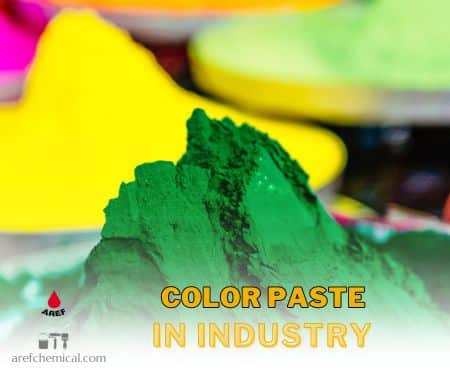What is color paste?
Color paste refers to a thick-colored substance that contains pigments or dyes. This material is used to paint or decorate different surfaces. Also, this product is used in different industries and for different purposes.
The uses of color paste are very diverse. As:
-
Use in arts and crafts:
In arts and crafts, this paste is used in techniques such as screen printing or block printing. Also, artists and painters use this product to create attractive and detailed designs on fabric, paper, canvas, and other materials.
-
Application in hair color:
In the beauty and fashion industry, this substance can be used as a raw material in all kinds of hair colors. Hair color paste is a semi-permanent or temporary hair color that comes in the form of a paste or cream and is applied to the hair to change its color temporarily. This type of hair dye causes less damage to the hair compared to permanent dyes.
-
Color paste in the food industry:
In the food industry, this type of dough can be used for edible purposes. This product is often used in baking and decorating cakes and for coloring fondant, frosting, or other edible ingredients. The paste form allows precise color control when creating decorative elements on cakes and pastries.
-
Application in industrial and production uses:
In industry and production, this type of paint is used to color various products, including paints, coatings, plastics, and inks. These colored pastes are often very thick and are mixed with base materials to achieve the desired color.
What are the ingredients of color paste?
The composition of this paste can be very different depending on its intended use, but here we mention some of the common compounds and components found in this product:
- Pigments: The primary colors in this product are created with the help of pigments. Pigments are solid and insoluble particles that produce color by reflecting and absorbing light. Colors are soluble substances that create color through chemical interactions with the substance on which it is applied. The choice between pigments and dyes depends on the specific application of the color paste.
- Color base or carrier: This paste needs a raw material to carry pigments or colors that allow these materials to be mixed on that substrate. Depending on the type of paste, the base material can be water, oil, solvent, or a specialized adhesive. For example, in water-based color pastes, water acts as the main base.
- Thickeners and stabilizers: Thickeners and stabilizers are used for the consistency of the paste and to prevent pigments or colors from settling in the base. Common thickeners include cellulose derivatives, acrylic polymers, or natural gums such as guar gum. Stabilizers help maintain color uniformity and prevent them from separating.
- Modifiers: Depending on the application, various modifiers may be added to this material to enhance its properties. For example, in the food industry, food coloring pastes usually contain ingredients such as glycerin or corn syrup to improve texture.
- Preservatives and antioxidants: In some cases, preservatives and antioxidants are added to the paste to increase its shelf life and maintain color stability over time.
- Fillers: In certain applications, paint pastes may contain fillers or extenders to reduce cost and increase product volume. These filters are usually inert substances that do not have a significant effect on the properties of the paint.
It is important to note that the specific formulation of paint paste can vary significantly depending on its intended use. For example, the color paste used in the food industry will have different compositions compared to the color paste used in the paint or printing industry.
Manufacturers produce formulations that meet the requirements of color intensity, stability, application method, and safety standards specific to their industry and product.
What is the method of making color paste using pigments?
Making this material using pigments usually involves mixing the pigments with a suitable binder or carrier to create a consistent, easy-to-use colorant. The exact method can vary depending on the specific application and industry, but here is a general outline of the process:
- Pigments: Choose pigments based on the desired color and the properties of the paste. Pigments exist in various forms such as powder, paste, or dispersion.
- Base Material: Select the appropriate binder or carrier medium based on the intended use of the final product. Common options include water, oil, solvents, or specialty adhesives for specific applications.
- Thickeners: The use of these is optional but may be necessary to achieve the desired consistency and consistency of the paint paste.
- Mixing equipment: You need equipment such as a mixer or a suitable container to mix the ingredients.
Steps of making color paste using pigments:
- Measuring pigments: Start by measuring the right amount of pigments needed to achieve the desired color intensity. The amount of pigment used depends on the concentration of the particular pigment and the strength of the color you want to achieve.
- Prepare the carrier medium: Depending on your application, you can choose a suitable base such as water, oil, or solvent. For example, in the case of oil-based dough, you should start with oil.
- Mix the pigments and the base material: gradually add the measured pigments to the base and mix continuously. It is important to add the pigments slowly to avoid clumping and ensure even dispersion. Use appropriate safety measures such as wearing protective clothing, as some pigments may pose a health hazard if inhaled or in direct contact with the skin.
- Add thickeners or stabilizers (if needed): If the paint paste needs a thicker consistency or better consistency, add thickeners and stabilizers as recommended by the manufacturer. Thickeners can help achieve the desired paste consistency. Stabilizers also prevent pigment from settling in the foundation.
- Mix thoroughly: Continue to mix the ingredients until you get a smooth and uniform color. This process may take some time. It is necessary to ensure the uniform dispersion of pigments in the base.
- Test and Adjust: Test a small amount of the resulting material to make sure it meets your color and application requirements. If necessary, add more pigment or base material to achieve the desired color and consistency.
- Packaging and storage: After you are satisfied with the properties of the final product, pack it in suitable containers. Store the paint paste according to the manufacturer’s recommendations, taking into account factors such as temperature and shelf life.
Specific details and requirements for making paint paste can be different according to the scope of intended uses and relevant industry standards. Note that when working with pigments and chemicals, especially if you are dealing with potentially hazardous materials, be sure to follow safety guidelines and manufacturer’s instructions.
What are the uses of paint paste in the industry?
Paint paste is known as pigment paste or pigment paste in the paint and coating industry. This paste formulation contains pigments and adhesives and is used for a wide range of industrial applications due to its unique properties. Here are some common uses of this material in the industry:
- Production of paint and coating: This material is used as a base for the production of all kinds of paint and coating. Manufacturers can customize these pastes by adding pigments, extenders, and special additives to achieve the color, texture, and special characteristics they desire. It acts as a concentrated source of color and can be easily incorporated into a variety of color formulations.
- Printing inks: In the printing industry, especially in offset and gravure printing, this product is used to produce high-quality inks. These inks are used for printing on various materials such as paper, cardboard, plastic, and packaging materials. This product provides the possibility of accurate and stable color matching in large-scale printing operations.
- Fabric Printing: Fabric manufacturers use this material to create vivid and durable printed designs on fabrics. This material is applied through various printing methods such as screen printing or rotary printing on textile materials. The use of this product provides the possibility for complex and precise designs and at the same time guarantees color stability and durability.
- Construction Industry: In the construction industry, this paste is used to paint building materials such as plaster, concrete, mortar, and grout. This method allows builders and contractors to achieve specific aesthetic and functional requirements for construction projects, such as colored concrete or decorative coatings.
- Automotive industry: Paint paste is an integral part of automotive paint production. This material helps car manufacturers to achieve stable and high-quality colors on cars. Car paints must have exact standards for durability, weather resistance, and appearance, and therefore this material plays an important role in meeting these requirements.
- Furniture and wood coatings: This product is used to create wood stains, varnishes, and coatings for furniture and wood products. This material allows manufacturers to offer a wide range of wood coatings, colors, and effects, improving the appearance and protection of wood surfaces.
- Industrial Coatings: Various industrial applications require specialized coatings for corrosion protection, chemical resistance, or other special purposes. Color paste is used to formulate custom coatings that meet these unique needs.
- Aerospace and marine coatings: In industries such as aerospace and marine industries, coatings must withstand extreme environmental conditions. This type of paste is used to create coatings that are not only protective but also visually appealing and allow naming and identification.
- Packaging materials: This material is used to color packaging materials such as films and plastic containers to increase their visual appeal and branding. This is especially important for consumer products where packaging beauty plays an important role in marketing.
- Specialty Applications: This specialty product can be used for many specialty applications, including anti-graffiti coatings, road markings, safety coatings, and more. The use of paint paste in these industries shows its versatility and importance in achieving the desired appearance, protection, and performance of products and different surfaces.
Buy color paste from Aref Chemical:
With years of experience in the paint and pigment paste industry, Aref Chemical has offered very high-quality products to the market. Glue, paint, and pigment paste products with Aref and Hisense brands of the highest quality and exceptional prices can compete with the biggest foreign brands in various industries.
We suggest you visit our products page. Also, by following Aref Chemical’s page on Instagram, find out about the latest news and events in this industry. Our colleagues are responsive to your needs, esteemed customers, and around the clock.







18 Responses
[…] are used in making the slime game and it is shaped manually by using different types of materials, colors, and decorations. This game can be useful as a creative and educational activity for children and […]
That was a very interesting article, thank you.
https://qomtamirat.com/
great
https://daroosf.com/%D9%85%DA%A9%D9%85%D9%84-%D8%B2%DB%8C%D9%86%DA%A9/
great
https://tavatranslation.com/%da%a9%d8%a7%d8%b1-%d8%af%d8%b1-%d9%81%d8%b1%d8%a7%d9%86%d8%b3%d9%87/
good luck
https://daroosf.com/%D9%85%DA%A9%D9%85%D9%84-%D8%A7%D9%86%D8%B1%DA%98%DB%8C-%D8%B2%D8%A7/
oh my God
https://qomtamirat.com/
yes
https://arefchemical.ir/%d8%a7%d9%86%d9%88%d8%a7%d8%b9-%d8%b1%d9%86%da%af-%d8%b3%d8%a7%d8%ae%d8%aa%d9%85%d8%a7%d9%86%db%8c/
i agree with you
https://behdama.com/%d8%b3%d8%ae%d8%aa%db%8c-%da%af%db%8c%d8%b1-%d8%a2%d8%a8/
oh thanks
https://qomtamirat.com/
exactly
https://daroosf.com/%D9%85%DA%A9%D9%85%D9%84-%D8%A7%D9%86%D8%B1%DA%98%DB%8C-%D8%B2%D8%A7/
true
https://tavatranslation.com/%da%a9%d8%a7%d8%b1-%d8%af%d8%b1-%d9%81%d8%b1%d8%a7%d9%86%d8%b3%d9%87/
really useful
https://arefchemical.ir/%d8%a7%d9%86%d9%88%d8%a7%d8%b9-%d8%b1%d9%86%da%af-%d8%b3%d8%a7%d8%ae%d8%aa%d9%85%d8%a7%d9%86%db%8c/
good points
https://daroosf.com/%D9%88%DB%8C%D8%AA%D8%A7%D9%85%DB%8C%D9%86-%D8%AF%DB%8C-%D8%AF%D8%B1-%DA%A9%D9%88%D8%AF%DA%A9%D8%A7%D9%86/
0
Color paste, also known as color concentrate or pigment paste, is a concentrated mixture of pigments, resins, and additives used to impart color to various materials.
Wet Grinding: This involves dispersing pigments in a liquid medium using high-energy mills (e.g., bead mills or ball mills). The mechanical action breaks down the pigment particles and helps achieve a uniform consistency.
The process begins with pre-mixing solid pigments with a resin or polymer. This ensures that the pigments are evenly distributed and enhances the stability of the final product.
So usefull
So great dear